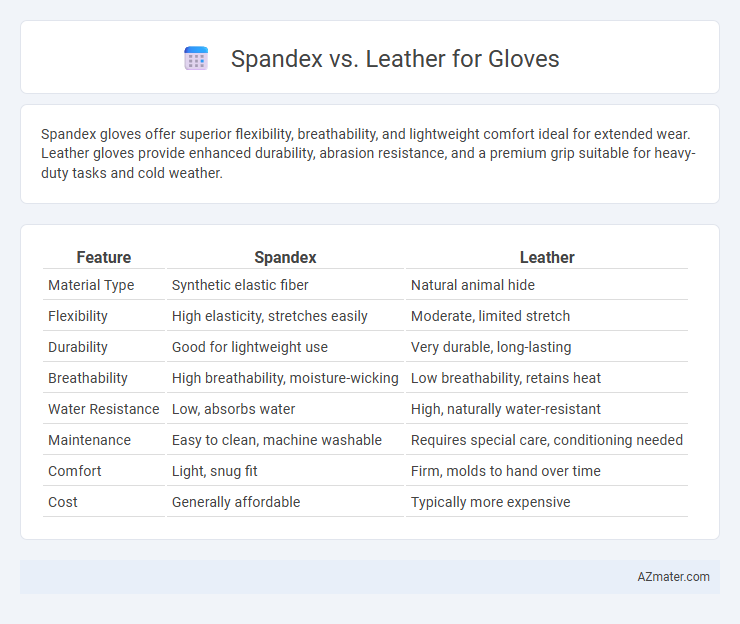Spandex gloves offer superior flexibility, breathability, and lightweight comfort ideal for extended wear. Leather gloves provide enhanced durability, abrasion resistance, and a premium grip suitable for heavy-duty tasks and cold weather.
Table of Comparison
| Feature | Spandex | Leather |
|---|---|---|
| Material Type | Synthetic elastic fiber | Natural animal hide |
| Flexibility | High elasticity, stretches easily | Moderate, limited stretch |
| Durability | Good for lightweight use | Very durable, long-lasting |
| Breathability | High breathability, moisture-wicking | Low breathability, retains heat |
| Water Resistance | Low, absorbs water | High, naturally water-resistant |
| Maintenance | Easy to clean, machine washable | Requires special care, conditioning needed |
| Comfort | Light, snug fit | Firm, molds to hand over time |
| Cost | Generally affordable | Typically more expensive |
Introduction: Spandex vs Leather Gloves
Spandex gloves offer exceptional flexibility and breathability, making them ideal for activities requiring dexterity and comfort. Leather gloves provide superior durability, protection, and a classic aesthetic, suitable for heavy-duty tasks and cold weather. Choosing between spandex and leather gloves depends on the balance between flexibility and toughness needed for specific uses.
Material Composition and Properties
Spandex gloves consist primarily of synthetic elastane fibers known for exceptional elasticity and breathability, offering a snug fit that enhances dexterity and comfort during prolonged use. Leather gloves, made from animal hides such as cowhide or goatskin, provide superior durability, abrasion resistance, and natural insulation, making them ideal for heavy-duty tasks and cold weather conditions. While spandex excels in flexibility and moisture-wicking properties, leather outperforms in toughness, protection, and longevity, catering to distinct functional requirements.
Comfort and Fit Comparison
Spandex gloves offer superior stretchability and breathability, ensuring a snug fit that adapts to various hand shapes for enhanced comfort during extended wear. In contrast, leather gloves provide a more rigid structure with limited flexibility, delivering durability but often sacrificing some degree of comfort and fit customization. The choice between spandex and leather gloves depends largely on the required level of mobility and the desired balance between softness and protection.
Durability and Longevity
Leather gloves offer superior durability and longevity due to their natural resistance to wear, punctures, and abrasions, often lasting several years with proper care. Spandex gloves, while flexible and lightweight, generally have a shorter lifespan as the synthetic fibers tend to stretch out and degrade faster with repeated use. For long-term investment in glove durability, leather remains the optimal choice when compared to spandex.
Breathability and Moisture Control
Spandex gloves offer superior breathability due to their stretchable knit structure, allowing air circulation and reducing sweat buildup on the hands. Leather gloves provide moderate moisture control by naturally wicking some moisture away but tend to trap heat and sweat more than spandex, leading to discomfort during prolonged use. For activities requiring enhanced ventilation and moisture management, spandex is the optimal choice over leather.
Flexibility and Range of Motion
Spandex gloves offer superior flexibility and an enhanced range of motion due to their stretchable fabric, allowing fingers to move freely without restriction. Leather gloves provide durability and protection but tend to be stiffer, which can limit finger dexterity and flexibility over time. For activities requiring high precision and agility, spandex is preferred, while leather suits tasks needing robust hand protection.
Protection and Safety Features
Spandex gloves offer lightweight flexibility and breathability but provide limited protection against cuts, abrasions, and impacts compared to leather gloves. Leather gloves deliver superior durability, resistance to punctures, and enhanced grip, making them ideal for heavy-duty tasks requiring robust hand protection. The natural toughness and heat resistance of leather significantly improve safety in environments with mechanical hazards or exposure to rough surfaces.
Aesthetic and Style Differences
Spandex gloves offer a sleek, form-fitting appearance with a smooth texture that emphasizes flexibility and modern athletic style, ideal for active or casual wear. Leather gloves exude classic elegance and durability with a natural grain texture, often preferred for formal settings and a timeless, sophisticated look. The choice between spandex and leather gloves directly impacts the visual appeal, balancing contemporary fashion trends against traditional luxury aesthetics.
Ideal Uses for Spandex Gloves
Spandex gloves excel in activities requiring flexibility and breathability, such as fitness workouts, driving, or light industrial tasks where dexterity is crucial. Their lightweight, stretchable fabric offers superior comfort and moisture-wicking properties, making them ideal for prolonged wear in warm environments. Unlike leather gloves, spandex gloves are not suited for heavy-duty protection but provide enhanced movement and ventilation for precision tasks.
Ideal Uses for Leather Gloves
Leather gloves provide superior durability, making them ideal for heavy-duty tasks such as construction, gardening, and industrial work. Their natural material offers excellent protection against abrasions, cuts, and exposure to harsh environments, ensuring long-lasting performance. Leather also provides a comfortable fit and breathability, suitable for activities requiring both protection and dexterity.

Infographic: Spandex vs Leather for Glove
 azmater.com
azmater.com